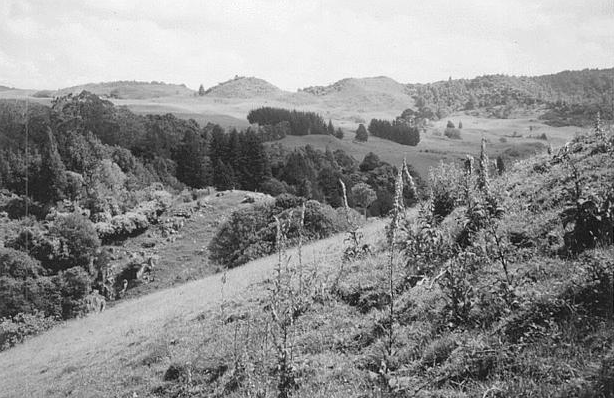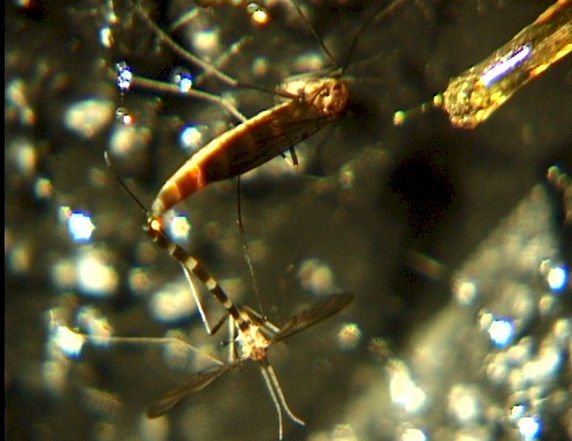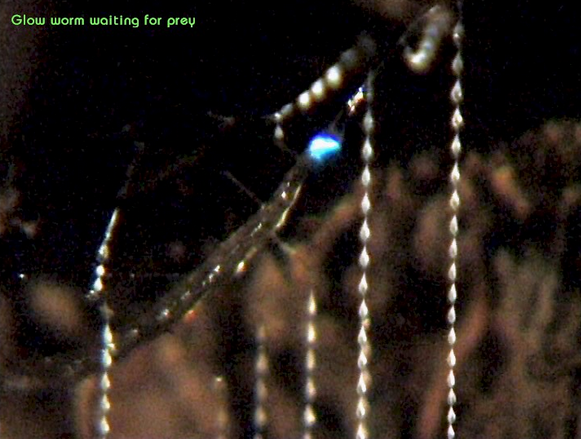Waitomo: New Zealand’s Glow-Worm Caves
Sophia Sherman
From In Context #13 (Spring, 2005)
In December 2004, I took a trip to New Zealand, with six weeks to explore the country’s natural wonders and volunteer on organic farms. New Zealand consists of two large islands with beaches, bays, and fjords, and many smaller islands along their coasts. Near the center of the North Island is a region called Waitomo, where steeply rolling green hillsides, cleared long ago of native bush, provide pasture for thousands of cows and sheep.
Landscape where glow-worm caves occur in the Waitomo region of New Zealand. (Photo: Sophia Sherman)
At 40 degrees latitude — nearly identical but inverse to my home in Harlemville, New York — the temperate climate of this South Pacific countryside supports the same European grasses and flowers that are naturalized in the northeastern U.S. December in Waitomo smelled deliciously and uncannily like June in Harlemville. Others have described it as a replica of English farmland. Clovers, plantains, dandelions, and grasses bloom alongside wild foxglove and lupines. Lush native ferns, mosses, and liverworts flourish in small stands of trees and pockets of bush.
Despite the familiarity, something about the landscape pulled vaguely at my attention. The hills were not rounded with glacial history, nor were the valleys wide flood plains or steep, river-cut waterways. The land appeared folded, almost like a thick cloth spread flat then scrunched up into clumps and ridges. Glow-worms had drawn me to the area, and their remarkable flourishing in that particular region turned out to be directly related to the curious landscape.
Waitomo is an indigenous Maori name meaning water hole or water shaft. The bedrock in the region is limestone, run through by over three-hundred known caves of various shapes and sizes, a number of which are several miles long. Streams flow through many of these natural tunnels, and it is in this dark, damp world that glow-worms thrive. When portions of the caves collapse, deep shafts open, through which humans and other life forms gain access to a realm of marvelous rock formations and the intriguing, luminous larvae. A wide range of viewing and adventuring options are available to interested visitors, from gentle guided walks to rock climbing and blackwater rafting or tubing. I chose a trip called Rap, Rock, and Raft.
Along with an Australian teenager and her father, I squeaked and tugged my way into the necessary, damp gear-full wet suit, climbing harness, rubber boots, and a helmet with attached head lamp and waist-belt battery pack. We bounced off in a damp jeep, following a long, winding track of white gravel through sunny pastures. At last we stopped in the middle of a field, just above a stand of poplars nestled into one of the folds of land. White sheep munched and looked on calmly as we stepped awkwardly out onto the grass. Making our way down into the trees, I realized what gave the landscape — at least in part — its unique contour. The hills hadn’t been thrust upwards or simply eroded; in many places, the earth between them had fallen in.
I had to walk deep into the steep, green crease before I had any idea where the cave entrance was. At the end of a tiny wooden walkway, I could suddenly see eighty feet into the earth through a great crack about twelve feet wide. Following our guide’s instructions, I clipped into the abseil rope and began lowering myself down towards the stream running over the dark rocks below. At first the walls of the chasm were lit by the sun, with clumps of grasses and flowers growing on little ledges. As I descended, I passed ferns, mosses, lichens, and liverworts, until eventually even those gave way to bare, clammy rock and flowing water. At the bottom I scrambled along the slippery, uneven ground to a place where I could look up through a wider opening at a narrow strip of sky and distant fringe of green. Another set of ropes hung there, ready for our climb out. The stream flowed swiftly out of a dark tunnel on my right, through the broad, open cavern where I stood, and back into a tunnel of rushing, echoing blackness to my left.
Once the whole group had reached the bottom, our guide unlashed an inner tube for each of us from the rope anchored to the cave wall, showed us how to turn our headlamps on and off, and started walking rapidly upstream. Cold water gushed into my rubber boots and seeped into my wetsuit as I stepped into the current. At first it was all we could do to carry our tubes and keep our footing on the uneven streambed, but we gradually settled into a reasonably steady pace and our eyes began adjusting to the darkness. Although the dimensions varied, the cave was usually about twelve feet high and wide, with frequent turns that soon blocked all daylight. The water quickly went from mid-thigh to waist-deep. We had to concentrate so hard on walking for the first 15 minutes or so that none of us even looked for glow-worms.
Suddenly our guide stopped and told us to pull our tubes up onto a sandy bank, make ourselves comfortable, and turn off our headlamps. We lounged back and looked around, immediately awestruck. We had entered a wide cavern, and the ceiling shone like the brightest night sky imaginable. Innumerable small points of pale green light glowed steadily on the vast expanse of ceiling. As our eyes adjusted to the new darkness, the lights seemed to grow even brighter. The water, winding away through the blackness, gleamed along all its visible length, as if luminous with starlight. The air was fresh and cool; the cave felt serene and spacious. We settled comfortably into the sand as our guide began to tell us about glow-worms.
Male and female flies mating adjacent to a pupal casing (upper right) from which the female (top center) has emerged. The two flies form an approximate ‘V’. (Photo courtesy of the Springbrook Glow Worms Research Centre)
The glow-worms in Waitomo are actually not worms at all, but the larval form of the fungus gnat, Arachnocampa Luminosa. During their approximately nine-month larval stage, they grow from less than 2 mm. to an inch or more in length. They then pupate for about two weeks in cocoons suspended from the cave ceiling. The adult insects, which look similar to large mosquitoes, have only the most rudimentary gastrointestinal tracts and cannot eat. They live for only two or three days — just enough time to mate and lay a cluster of eggs on the walls or ceiling of the cave. When the larvae hatch after about three weeks, they immediately begin glowing and migrating toward available ceiling space above the water.
A glow-worm lies in wait for its prey. Its body extends from the lower left toward the upper right, with the glow at its upper end. What look like strings of beads are the sticky filaments for trapping insects. (Photo courtesy of the Springbrook Glow Worms Research Centre)
The larvae can live in any place that is moist, dark at least some of the time, and where there is an overhang from which to suspend their hammock webs or “nests.” They trail long sticky filaments of “fishing line” into the air below them, as many as 70 strands per larva, snagging and reeling in the insects that fly toward the green lights.
Although glow-worms live in open-air grottos and sheltered banks throughout New Zealand and parts of Australia, the Waitomo caves provide unusually ideal habitat. Since the larvae can only attract insects in the dark, the underground world provides uninterrupted “gathering” conditions. With so many shaft openings, insects are continually entering the cave system and flying through the fresh air that flows with the water. Whether these potential food sources are simply drawn to the light of the glow-worms or mistake the brightness above for the night sky, they consistently fly upwards and become entangled in the fishing lines. The stillness of the air allows the lines to hang free without getting stuck together and also keeps the larvae from drying out as they would in windy conditions.
Glow-worms are remarkably energy-efficient, and can bioluminesce for up to three months without eating. Their light is a form of phosphorescence, the result of a chemical reaction between ATP, luciferin, luciferase, and oxygen, in which no heat is given off. The larvae shining brightest are supposed to be the most hungry. Glow-worms can also survive a number of days submerged in water when the caves flood. Several months before my trip, however, two weeks of sustained high water had washed away the colony in the cave we were visiting. Slowly the population had returned to its usual massive size and brilliance.
Because direct light causes the glow-worms to go dark, after which it takes them several hours to regain full food-attracting brightness, we never actually saw the bodily form of a larva or an adult. We saw only their gleaming lights and the soft, dangling shimmer of their fishing lines.
Full of amazement, we put our tubes into the water, beginning the blackwater tubing portion of our trip. With our eyes fully adjusted and our bodies nestled into the bouyant rubber, we floated through the luminous darkness. Spinning in the current, we gazed at the subterranean sky above us, soaking up the magic as daylight dawned around the last bend.
We drifted on past our access shaft, riding some rapids and scrambling through dry side caves before walking back upstream to our exit. We replaced the tubes, then one by one clipped into the belay rope and climbed the pitted, vertical wall into the lichens and mosses, the ferns and fragrant warmth. The late sun shone deeply golden across the hills, somehow a more precious light in a more marvelous world than I had been aware of a few hours before.



